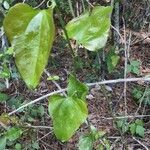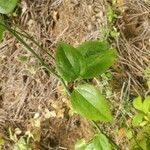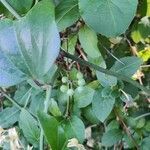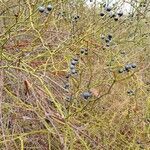Slender woody vine; stems usually quadrangular, diffusely branched and often climbing high, with scattered stout, flattened prickles below; lvs deciduous, thin, green, shining, ovate to rotund or triangular-ovate, 5–10 × 4–9 cm, or smaller in dry soils, acute to cuspidate or obtuse, entire or rarely sparsely roughened on the margins, at base broadly rounded to truncate or cordate, 5-or 7-nerved, reticulate beneath at maturity; peduncles flattened, about as long as the subtending petioles; staminate tep recurved only above the middle; fr black, usually glaucous, mostly 2–3-seeded; 2n=32. Open woods, thickets, and roadsides; N.S. to n. Fla., w. to Mich., se. Mo., e. Okla., and e. Tex., the commonest greenbrier in the ne. part of our range. May, June.
A prickly vine. It is woody and loses many leaves during the year. It keeps growing from year to year. The stems are four sided. They are tough and green and become woody after the first year. It grows 10 m long. The branches have long tough tendrils. There are sharp sturdy thorns. The leaves are alternate. They are widest near the base and pointed at the tip. They are leathery, shiny and light brown when young but becoming dark green when older. The flowers are small and light green Male and female flowers are separate. They are in round clusters at the ends of stalks.










